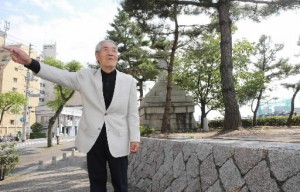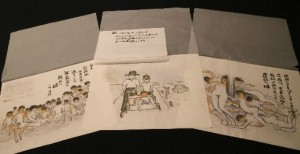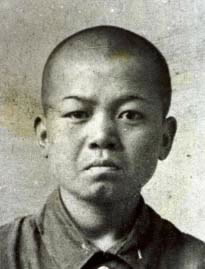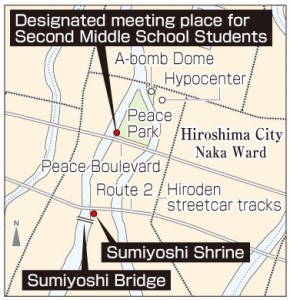Hiroshima: 70 Years After the A-bombing: Depicting the A-bombing 4
Oct. 24, 2014
Brothers happy to find each other amid the catastrophe
Norihiko Myoken, 84, a resident of Minami Ward, Hiroshima, looked at Sumiyoshi Bridge and said, “I remember this stone lantern.”
The stone lantern was erected during the Meiji Period (1868-1912) to commemorate the completion of Sumiyoshi Bridge, spanning the Honkawa River, which runs through the Hiroshima delta. The lantern still stands by the east end of the bridge. Years ago, at the south side of the lantern, Mr. Myoken found his brother, who was seriously wounded by the atomic bombing.
“The education we received told us to sacrifice our lives for our country,” said Mr. Myoken, recalling the wartime mobilization of students. “I’m sure my brother felt the same way.”
August 6, 1945 was another day that Mr. Myoken was mobilized to work at the Mitsubishi Heavy Industries Hiroshima Shipyard in Eba-machi, Naka Ward. He was a fourth-year student at Matsumoto Technical High School (now Setouchi High School). After the national government issued the Student Labor Service Order, he was mobilized for daily work at the factory.
Mr. Myoken’s younger brother, Yoshihiro, then 13, was a first-year student at Hiroshima Second Middle School (now Kanon High School). He was mobilized to the east bank of the Honkawa River, by today’s Peace Memorial Park, to help dismantle houses in the area to create a fire lane in the event of air raids.
When the atomic bomb exploded, Mr. Myoken was near the front gate of the shipyard. He walked through the city center, which was engulfed with flames and searing heat, and crossed Inari Bridge on all fours. It was a bridge for trams, and the rails were warped by the blast. He finally arrived home in Niho-machi (today’s Mukainada Ohara-cho) that evening, but his brother was not there.
“When I called his name, he replied.”
Two days later, Mr. Myoken heard that his brother, Yoshihiro, was at a temporary relief station near Sumiyoshi Bridge. Pushing a hand-made cart, he went there with his uncle. He was the eldest son of the six children in his family. His father was not at home because he had been drafted into military service.
Yoshihiro was lying in a tent. Mr. Myoken saw the dark blue underwear made by his mother. “My brother was seriously burned from his face to his right arm. When I called his name, he replied, ‘Yes.’”
On the way home, Yoshihiro said, “I want some water,” then became quiet. He died at home on the following day, August 9. Mr. Myoken took Yoshihiro’s body to the grounds of Aosaki National School (now Aosaki Elementary School), from which Yoshihiro had graduated that spring, and cremated his body there.
After the war, Mr. Myoken received training at a tailor’s shop and worked at the Hiroshima branch of Tenmaya Department Store until he retired. He made pictures of the atomic bombing in 2002, when he learned from a newspaper article that pictures by survivors were being collected. He had taken up oil painting, as a hobby, in his forties. Up until the time he made these pictures, he had not told about his experience of the atomic bombing in any detail to his wife Toshie, 82, or to his children or grandchildren.
Encouraged by his wife
Mr. Myoken had tried to bury his memories of the atomic bombing, but then he vividly remembered not only the terrible injuries suffered by his brother but also the sights of people fleeing to Ebayama Hill near the shipyard and dead bodies floating down to the Inari tram bridge on the Kyobashi River. He chose to create these pictures with water color, not with oil paints, which would have taken more time.
When he hesitated about submitting the picture of his suffering brother, whom he himself had cremated, his wife encouraged him. “My wife told me that I was fortunate to be able to find my brother in those terrible conditions,” he said. “She encouraged me to submit the picture.”
Mr. Myoken attached a piece of paper to the picture of his brother, which read: “I am deeply grateful to Shigeyuki Nakagawa’s mother, who told us that my brother was alive and where we could find him. Shigeyuki was one of my brother’s classmates at the former Hiroshima Second Middle School.”
Shigeyuki Nakagawa, then 12, who was in the same class of first-year middle school students, died on the same day that Mr. Myoken’s brother passed away--three days after the bombing--at a relief station in Saeki-gun. According to his family, his mother, Kikumi, found him and put him in a truck that happened to pass by. Because she went on to look for his classmates, she was unable to be with her son when he died. A total of 321 first-year students of that middle school lost their lives to the atomic bomb.
“If Nakagawa’s mother hadn’t sent us a message, I would never have found my brother,” Mr. Myoken said. “To me, she’s like our ‘mother,’ making it possible for us to see each other.”
At Mr. Myoken’s home is an oil painting of the atomic bombing. The painting, which he began after submitting his A-bomb pictures, took him seven years to complete. It depicts the Prefectural Industrial Promotion Hall (now the A-bomb Dome), heavily damaged, and the ruins of the Hatchbori area, while he appears in the scene with his back turned, wearing a field cap. It is painted in red, which evokes the fires of war, and white, a color to express prayers for the repose of the victims.
“If we get so used to having peace, and we don’t try to grasp the reality of war, this could happen again,” Mr. Myoken said. On the back of his oil painting is the notation: “15 years old, summer.”
(Originally published on September 29, 2014)











